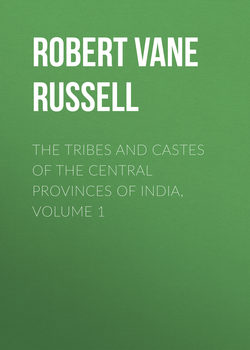Читать книгу The Tribes and Castes of the Central Provinces of India, Volume 1 - Robert Vane Russell - Страница 14
Part I.
Introductory Essay on Caste
Introductory Essay on Caste
11. Entry of the Aryans into India. The Aryas and Dasyus
ОглавлениеM. Emile Senart, in his work Les Castes dans l’Inde, gives an admirable sketch of the features marking the entry of the Aryans into India and their acquisition of the country, from which the following account is largely taken. The institution of caste as it is understood at present did not exist among the Aryans of the Vedic period, on their first entry into India. The word varna, literally ‘colour,’ which is afterwards used in speaking of the four castes, distinguishes in the Vedas two classes only: there are the Arya Varna and the Dasa Varna—the Aryan race and the race of enemies. In other passages the Dasyus are spoken of as black, and Indra is praised for protecting the Aryan colour. In later literature the black race, Krishna Varna, are opposed to the Brāhmans, and the same word is used of the distinction between Aryas and Sūdras. The word varna was thus used, in the first place, not of four castes, but of two hostile races, one white and the other black. It is said that Indra divided the fields among his white-coloured people after destroying the Dasyus, by whom may be understood the indigenous barbarian races.2 The word Dasyu, which frequently recurs in the Vedas, probably refers to the people of foreign countries or provinces like the Goim or Gentiles of the Hebrews. The Dasyus were not altogether barbarians, for they had cities and other institutions showing a partial civilisation, though the Aryas, lately from more bracing climes than those which they inhabited, proved too strong for them.3 To the Aryans the word Dasyu had the meaning of one who not only did not perform religious rites, but attempted to harass their performers. Another verse says, “Distinguish, O Indra, between the Aryas and those who are Dasyus: punishing those who perform no religious rites; compel them to submit to the sacrifices; be thou the powerful, the encourager of the sacrificer.”4
Rakshasa was another designation given to the tribes with whom the Aryans were in hostility. Its meaning is strong, gigantic or powerful, and among the modern Hindus it is a word for a devil or demon. In the Satapatha Brāhmana of the white Yajur-Veda the Rakshasas are represented as ‘prohibiters,’ that is ‘prohibiters of the sacrifice.’5 Similarly, at a later period, Manu describes Aryavarrta, or the abode of the Aryas, as the country between the eastern and western oceans, and between the Himalayas and the Vindhyas, that is Hindustān, the Deccan being not then recognised as an abode of the Aryans. And he thus speaks of the country: “From a Brāhman born in Aryavarrta let all men on earth learn their several usages.” “That land on which the black antelope naturally grazes, is held fit for the performance of sacrifices; but the land of Mlechchhas (foreigners) is beyond it.” “Let the three first classes (Brāhmans, Kshatriyas and Vaishyas) invariably dwell in the above-mentioned countries; but a Sūdra distressed for subsistence may sojourn wherever he chooses.”6
Another passage states: “If some pious king belonging to the Kshatriya or some other caste should defeat the Mlechchhas7 and establish a settlement of the four castes in their territories, and accept the Mlechchhas thus defeated as Chandālas (the most impure caste in ancient Hindu society) as is the case in Aryavarrta, then that country also becomes fit for sacrifice. For no land is impure of itself. A land becomes so only by contact.” This passage is quoted by a Hindu writer with the same reference to the Code of Manu as the preceding one, but it is not found there and appears to be a gloss by a later writer, explaining how the country south of the Vindhyas, which is excluded by Manu, should be rendered fit for Aryan settlement.8 Similarly in a reference in the Brāhmanas to the migration of the Aryans eastward from the Punjab it is stated that Agni the fire-god flashed forth from the mouth of a priest invoking him at a sacrifice and burnt across all the five rivers, and as far as he burnt Brāhmans could live. Agni, as the god of fire by which the offerings were consumed, was addressed as follows: “We kindle thee at the sacrifice, O wise Agni, the sacrificer, the luminous, the mighty.”9 The sacrifices referred to were, in the early period, of domestic animals, the horse, ox or goat, the flesh of which was partaken of by the worshippers, and the sacred Soma-liquor, which was drunk by them; the prohibition or discouragement of animal sacrifices for the higher castes gradually came about at a later time, and was probably to a large extent due to the influence of Buddhism.
The early sacrifice was in the nature of a communal sacred meal at which the worshippers partook of the animal or liquor offered to the god. The Dasyus or indigenous Indian races could not worship the Aryan gods nor join in the sacrifices offered to them, which constituted the act of worship. They were a hostile race, but the hostility was felt and expressed on religious rather than racial grounds, as the latter term is understood at present.
2
Dr. Wilson’s Indian Caste (Times Press and Messrs. Blackwood), 1875, p. 88, quoting from Rig-Veda.
3
Dr. Wilson’s Indian Caste (Times Press and Messrs. Blackwood), 1875, p. 88, quoting from Rig-Veda.
4
Rig-Veda, i. 11. Wilson, ibidem, p. 94.
5
Wilson, ibidem, p. 99.
6
Manu, ii. 17, 24.
7
Barbarians or foreigners.
8
See Burnett and Hopkins, Ordinances of Manu, s.v.
9
Wilson, Indian Caste, p. 170, quoting Weber, Indische Studien, i. 170.
